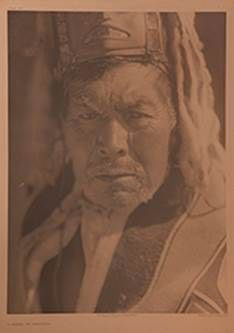Caption: “A Haida of Massett” (1915) – one of eight copper plates donated to SHI by Steven Kern and Kenneth Zerbe. |
Donors Steven Kern and Kenneth Zerbe, who purchased the photogravure plates in 1981 from the Classic Gravure Company, wanted SHI to have part of the Alaska portion of their collection, Kern said.
“We are thrilled and grateful to have these one-of-a-kind copper plates in our ethnographic collection. We are astounded by the generosity of the donors and glad we will have these for future generations to study,” said SHI President Rosita Worl.
The images were featured in Curtis’ life work The North American Indian — The Vanishing Race, a massive nearly 40-year project financed by JP Morgan and sponsored by President Theodore Roosevelt. The endeavor required Curtis to trek through the American West with wagons and cameras to document "The Vanishing Race" of Native American Tribes, according to The Curtis Gallery.
The work is published in twenty volumes of narrative text and ‘small’ photogravure images. Four additional volumes of ‘large’ photogravure images accompany these twenty volumes. The first volume of the twenty volumes was published in 1907, and the final volume of the twenty volumes was published in 1930, according to the gallery.
The negatives were transferred to plates by way of the photogravure process for inclusion in the series and a limited number of them made the final cut.
“Curtis took thousands of photographs but not all were chosen for inclusion in The North American Indian series,” said Kern.
The plates donated to SHI are titled A Haida Chief's Tomb at Yan (1915), A Haida of Massett (1915), A Haida of Kung (1915), Haida Slate Carvings (1915), Old Stone House-Diomede Island (1928), A Kotzebue Man (1928), Charlie Wood-Kobuk (1928) and Kobuk Costume (1928).
SHI routinely exhibits items in its ethnographic collection for the public.
About Photogravure Plates:
A photogravure plate is a copper plate upon which a photographic image has been etched.
The photogravure process, which dates to the 1850s, was the primary photographic “technology” prior to film. The process is rarely used today due its time-consuming complexity and, generally, the resulting photogravure print being limited to one color, usually sepia.
Thus, the photogravure plate, today, is an example of photographic history. For example, the Curtis photogravure plates were created between 1900 and 1930.
And, the actual printing from the photogravure plate is almost a lost art. (Source: The Curtis Gallery)
Edited By: Mary Kauffman, SitNews
Source of News:
Sealaska Heritage Institute
Representations of fact and opinions in comments posted are solely those of the individual posters and do not represent the opinions of Sitnews.
Send a letter to the editor@sitnews.us
SitNews ©2021
Stories In The News
Ketchikan, Alaska
Articles & photographs that appear in SitNews are considered protected by copyright and may not be reprinted without written permission from and payment of any required fees to the proper freelance writers and subscription services.
E-mail your news & photos to editor@sitnews.us
Photographers choosing to submit photographs for publication to SitNews are in doing so granting their permission for publication and for archiving. SitNews does not sell photographs. All requests for purchasing a photograph will be emailed to the photographer.

